
HISTORY History of Hachinohe Port
HISTORY History
Hachinohe Port was opened in 1939. After the designation of Hachinohe City as a New Industrial City in 1964, greater effort was put into the development and improvement of the port and its surrounding areas, resulting in the city growing into one of the most industrialized areas in the Tohoku region. The port celebrated its 80th anniversary in 2019.
| 1939 | Hachinohe Port opens |
|---|---|
| 1951 | Hachinohe Port designated as a major port |
| 1952 | Hachinohe Port designated as a port of entry or departure |
| 1959 | Hachinohe Port designated as a plant quarantine port |
| 1964 | Hachinohe City designated as a New Industrial City |
| 1965 | Hachinohe Port designated as a special port for lumber imports |
| 1969 | Hachinohe Port designated as a special port for crop imports |
| 1971 | Hachinohe Port designated as a special port for plant imports |
| 1993 | Hachinohe Port designated as an animal quarantine port |
| 1994 | Regular international container route established (Southeast Asia Route)*Discontinued in 2012 |
| 1995 | Hachinohe Port Logistics Globalization Promotion Council established |
| 1996 | Hachinohe Port designated as a foreign access zone (FAZ) |
| 1997 | Port Island (Kawaragi Pier No. 1) enters service |
| 1998 | Regular international container routes established (China, Korea, and North America Routes *Out of service at present) |
| 1999 | International feeder route established (anchorage: Yokohama Port, etc.) |
| 2003 | Hachinohe Port designated as an Integrated Reverse Logistic Base Port (Recycle Port) |
| 2006 | International feeder route established (anchorage: Keihin Port, etc.) |
| 2008 | International feeder route established (anchorage: Tokyo Port, etc.) |
| 2011 | Severe damage caused by the Great East Japan Earthquake |
| 2015 | Regular international container route established (Korea Route) |
| 2018 | Container yard expanded |

Related pages (Hachinohe City website)
Chronological table:https://www.city.hachinohe.aomori.jp/shisetsuannai/hachinohekou/9690.html
History of Hachinohe Port:https://www.city.hachinohe.aomori.jp/shisetsuannai/hachinohekou/8025.html
OPENING OF PORT Hachinohe Port opens
Birth of Hachinohe City and Port
About 350 years ago during Japan’s Edo period, the port in Hachinohe was called “Same Ura” (Shark Bay). At that time, it was used as a fishing and evacuation harbor on the Sanriku Coast. While goods from different ports in the Tohoku and Hokuriku regions had always been transported westwards to Osaka in the past, the establishment of eastern routes resulted in the port being used to transport goods to Edo (now Tokyo). As the maritime shipping industry in Japan began to take off during the Meiji period, ports were actively constructed throughout the country. Work to repair and reinforce the port in Same Ura commenced in 1919, and Hachinohe also accelerated its efforts to promote harbor works.
Sometime later in response to a move by the Home Ministry to designate a larger number of major ports, the local authorities decided that it was important for the port in Same Ura to be upgraded into a commercial port to promote the further development of Hachinohe and that it would be advantageous for Hachinohe to evolve from a group of villages into a large city to achieve this objective. Consequently, Hachinohe City was founded on May 1, 1929, following a series of discussions by four local municipalities (i.e., Same, Minato, Konakano, and Hachinohe) about a possible merger.
In December of the year in which Hachinohe City was founded, the port in Same Ura was merged with the area around the mouth of the Minato River to form a larger port and renamed Hachinohe Port. This port was designated by the Home Ministry in January of the following year, thereby laying the legal framework for the continued upgrading of the port. As the port improvement works steadily progressed, Hachinohe Port was designated a trade port in 1939 and a major port in 1951.

Improvement works underway in Hachinohe Port (1930)
Hachinohe City was bombed in air raids twice in 1945, once in July and once more in August, resulting in the destruction of various plant facilities, Shiriuchi Station, and many other buildings. Furthermore, a coastal defense ship called the Inaki, which was temporarily berthed at Hachinohe Port at that time, was sunk after an intense three-hour battle with US Grumman fighter planes on August 9. The Pacific War, which had a devastating impact on people’s lives, ended one week later on August 15.
-
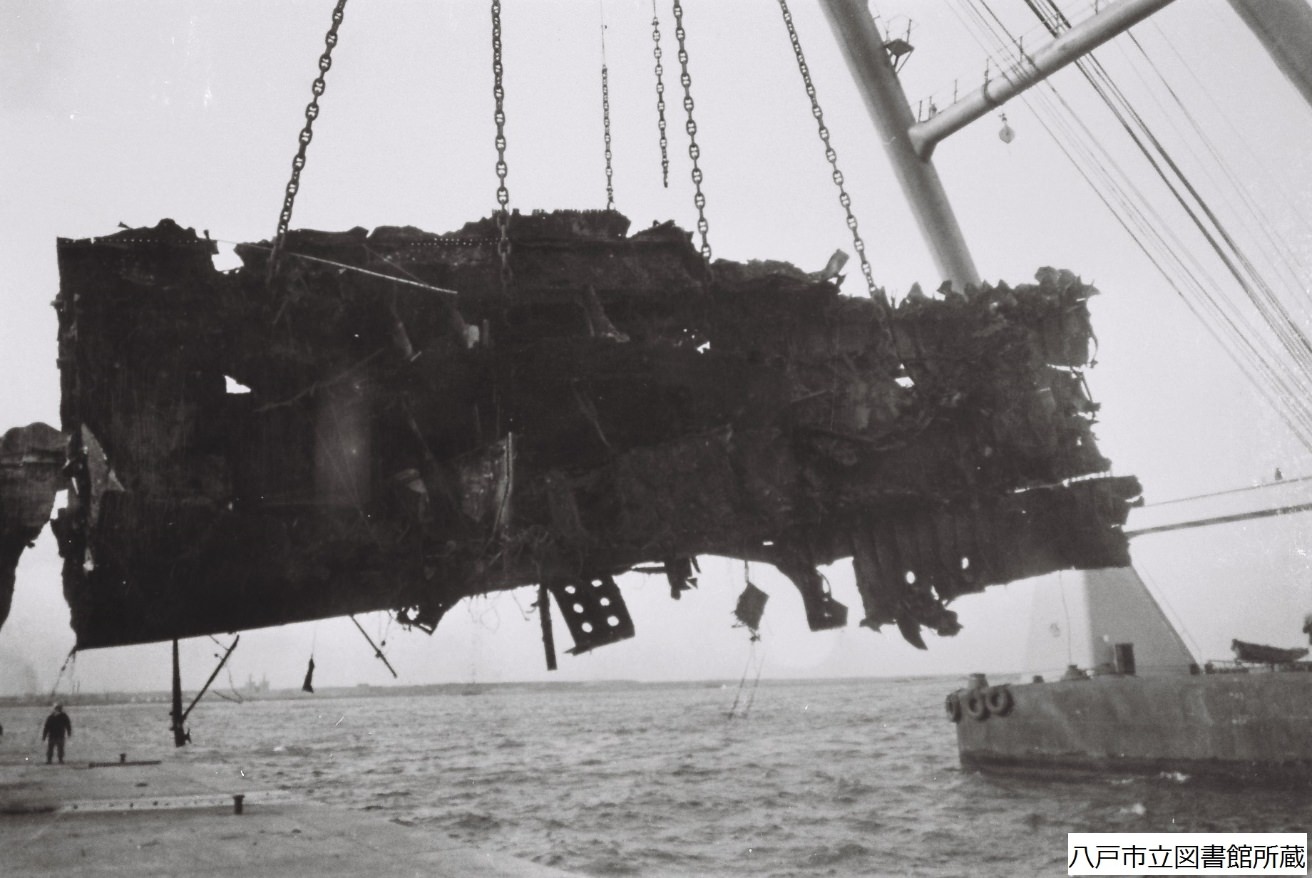
Remains of the coastal defense ship Inaki (1945)
In 1947, Hachinohe Port was designated as the shipping port for the sulfur ore produced at the Matsuo Mine in Iwate Prefecture for the manufacture of chemical fertilizers as part of Japan’s post-war efforts to increase food production. As wave protection measures urgently needed to be implemented to restore the port, sunken-ship breakwaters were set up using three 10,000-ton petroleum tankers that had been built during the war.
DESIGNATED AS A NEW INDUSTRIAL CITY Hachinohe City designated as a New Industrial City
Designation as a New Industrial City and rapid growth
Following the designation of Hachinohe City as a New Industrial City in 1964, full-scale port improvement works were undertaken, including the construction of large berths and ferry wharfs, while industries involved in the production of paper, non-ferrous metals, and other key materials were gradually built up in coastal areas. As a result, Hachinohe grew to become one of the most industrialized cities in Tohoku.
-
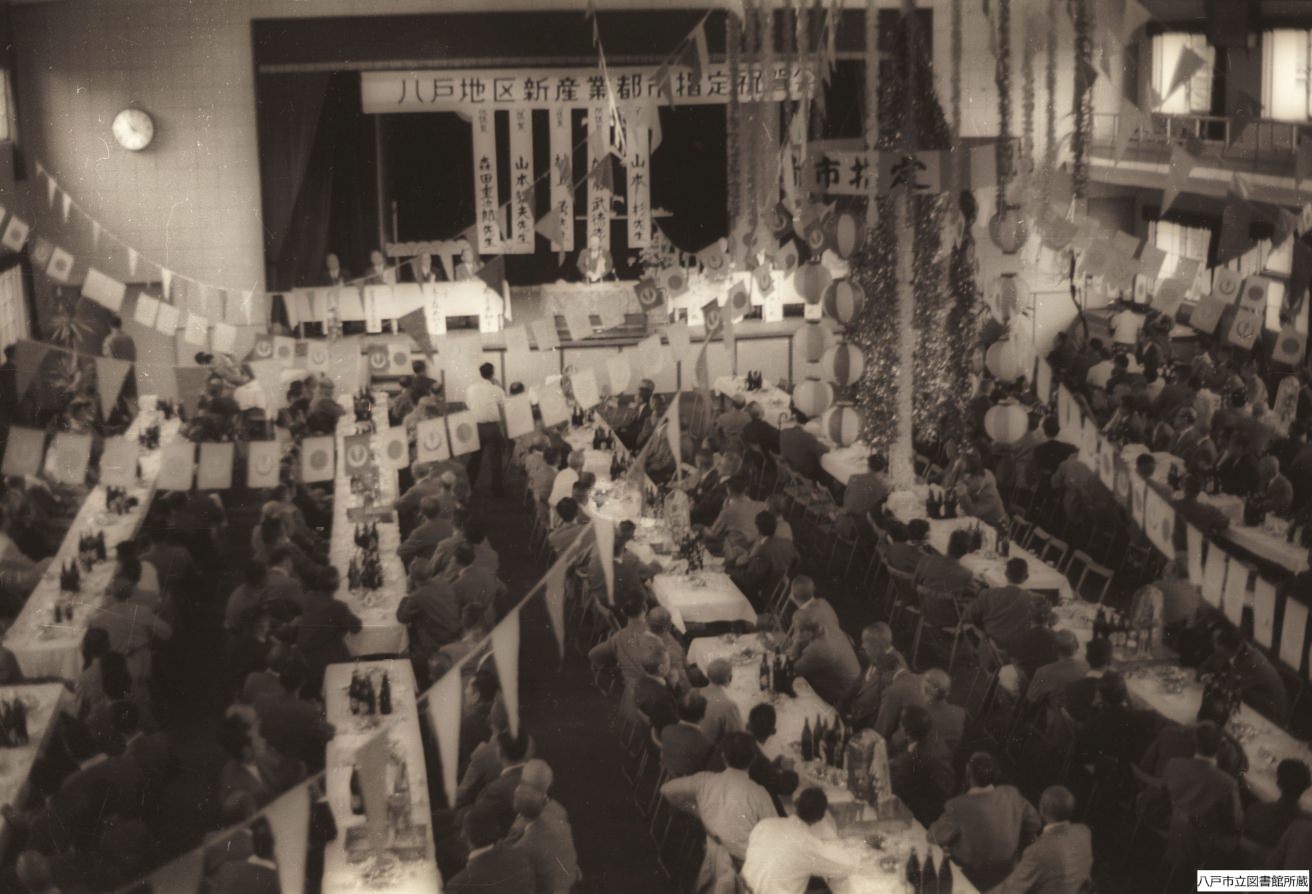
Ceremony celebrating the designation of Hachinohe City as a New Industrial City (1964)
In the area of logistics, car ferry services to and from Tomakomai (1973) and Muroran (1979) were launched (services between Hachinohe and Muroran were suspended in 2006 and then resumed in 2020). Completed at Hattaro Wharf No. 3 in 1981, the Hachinohe Ferry Terminal now serves as a hub connecting the main island of Japan and Hokkaido by providing four services a day to and from Tomakomai and one service a day to and from Muroran.
FAZ
Regular international container route established (Southeast Asia Route)
Foreign access zone (FAZ)
Hachinohe Port becomes the first port in Tohoku to establish regular ocean-going container routes
Hachinohe Port began handling container transport, which had become the main form of international logistics, in 1994 following its opening of the Southeast Asia Route, the first regular international container route from the Tohoku region. This marked the starting point of efforts to enhance Hachinohe Port as northern Tohoku’s hub port for international logistics. In 1995, Aomori Prefecture and Hachinohe City worked with the chambers of commerce and industry, port promotion organizations, financial institutions, port transport businesses and other related parties to jointly establish the Hachinohe Port Logistics Globalization Promotion Council. This council carries out various port sales activities, such as regularly sending missions abroad, with the aim of stimulating the regional economy by developing Hachinohe Port into an international logistics hub.
In 1996, the port was designated as a foreign access zone (FAZ) and the Hachinohe Port Trade Center was opened. Port Island (Kawaragi Wharf No. 1) entered service the following year in 1997.
Sometime later, the Korea Route (now the China/Korea Route) and the North America Route (suspended in 2008) were established in 1998. After that, inland feeder routes were established to connect Hachinohe Port to Yokohama Port in 1999, to Tokyo Port in 2006, and to Nagoya Port in 2008. Since the establishment of a new Korea Route in 2015, the convenience of the port has continued to be enhanced through initiatives such as the addition of new anchorage sites and an increased range of services.
-
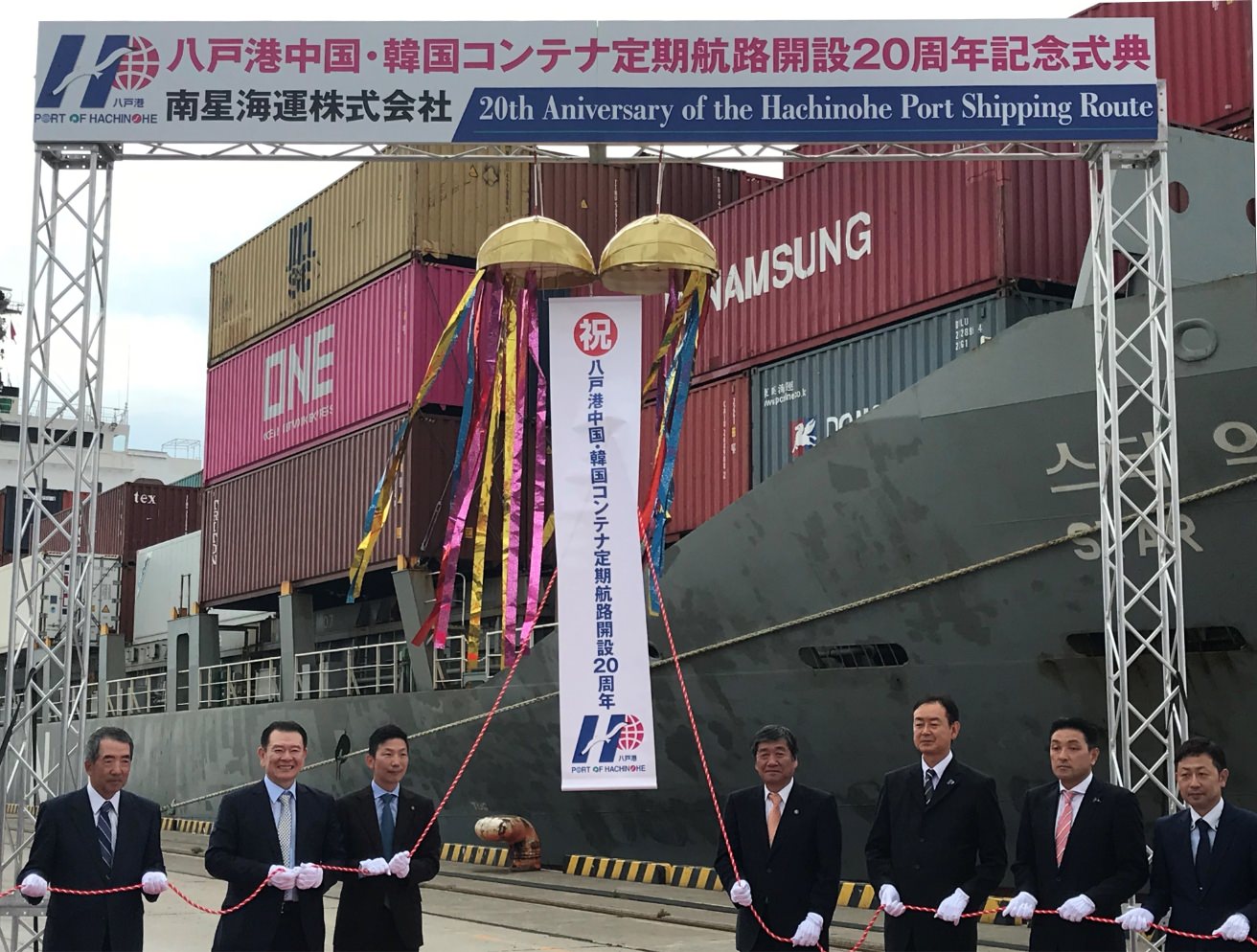
Ceremony celebrating the 20th anniversary of the China/Korea Route (2018)
Great damage caused by the Great East Japan Earthquake Severe damage caused by the Great East Japan Earthquake
Dramatic recovery from the Great East Japan Earthquake
-

Damage caused by the Great East Japan Earthquake (2011)
The Great East Japan Earthquake struck on March 11, 2011, causing severe damage to Hachinohe Port, particularly the Hattaro North Breakwater, and seriously interfering with the port’s logistics functions by, for example, disturbing the calmness of the waters there. After dropping as low as 30,000 TEU, the port’s container handling capacity recovered dramatically due to concerted efforts by the public and private sectors to reconstruct the port. Thanks to these efforts, the restoration work was completed in 2013, the earliest in Tohoku.
EXPANSION OF CONTAINER YARD AND START OF SERVICE Expansion of the container yard and start of service
Expansion of the container yard and reefer container plugs
-
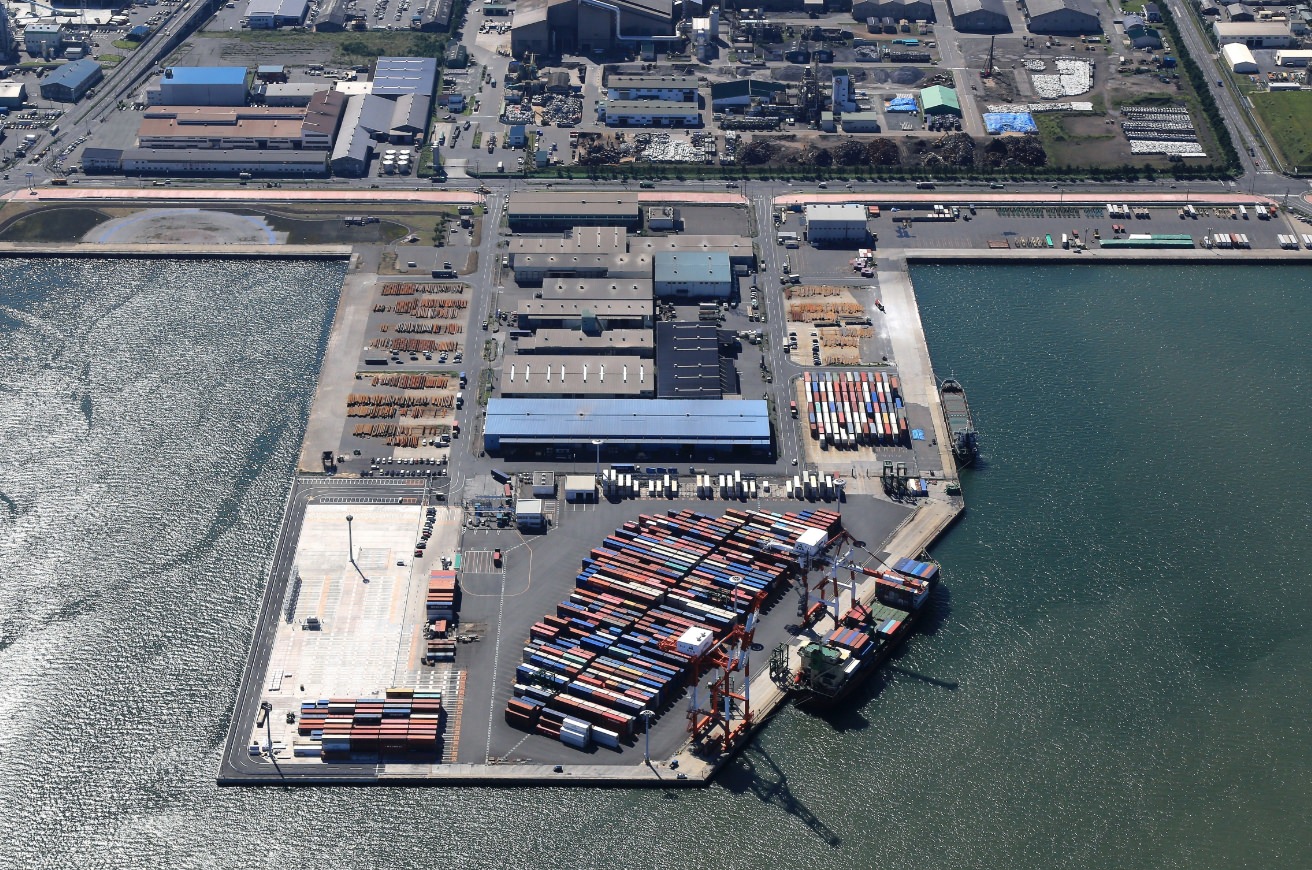
Expanded container terminal
Work to expand the container yard by two hectares was completed on September 18, 2018, with the yard entering full service on October 1 of the same year. This expansion increased the yard’s area by 29% and its annual handling capacity by 35%. In addition, 30 plugs were added for reefer containers (i.e., refrigerated/frozen containers used to transport goods at a constant temperature), thereby helping to improve the convenience of the port even further.
OPEN THE WORLD Aiming to be a “gateway port that opens northern Tohoku up to the world”
-
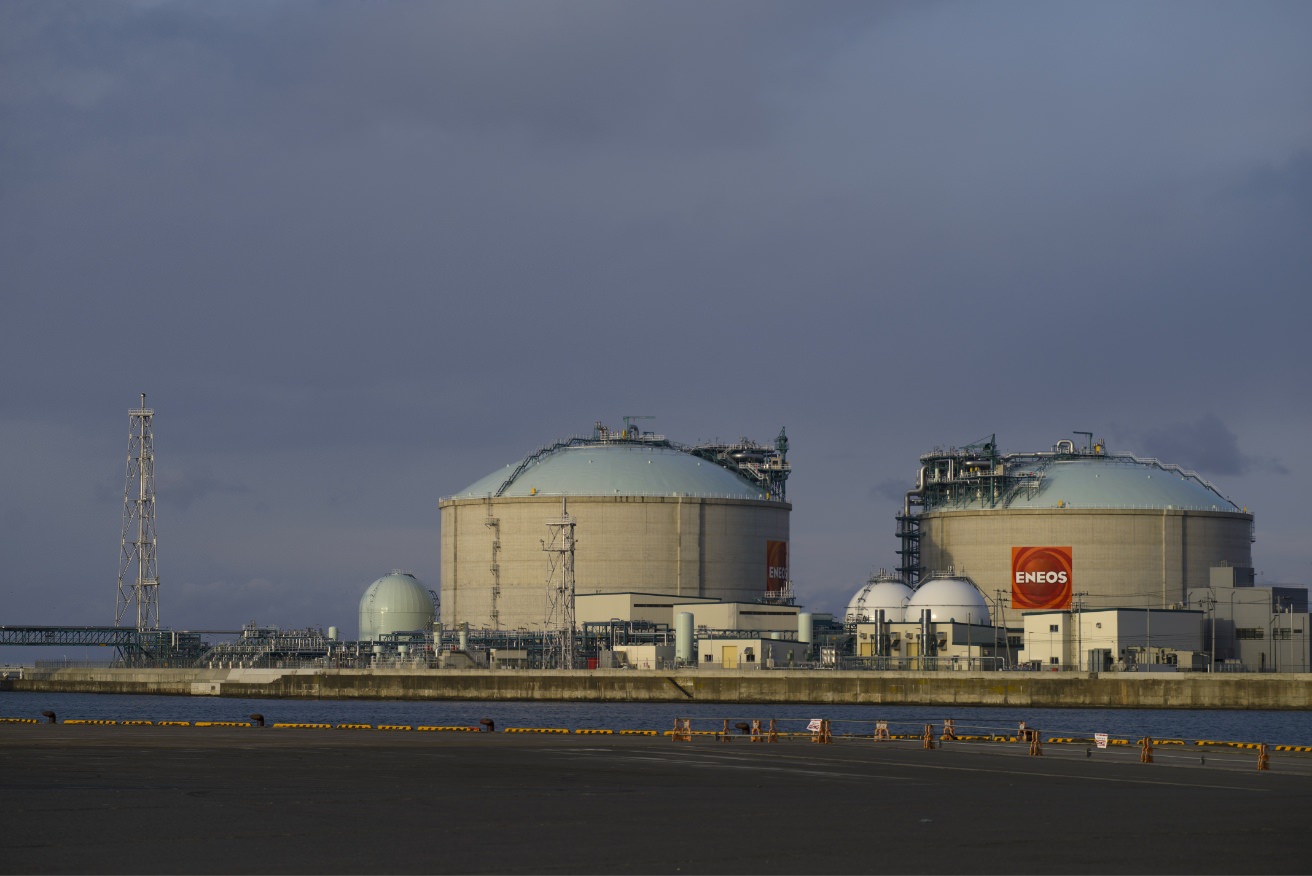
Hachinohe LNG Terminal
The port plan was revised in 2009 with the aim of developing Hachinohe Port into a “gateway port that opens northern Tohoku up to the world.” Set to be achieved by the mid- to late 2020s, this plan is intended to support industrial activities in the northern Tohoku region while also tackling more immediate tasks, such as coping with increasing volumes of container cargo, separating container cargo from bulk cargo, and taking care of user companies, in order to contribute to sustainable growth in the region.
In addition, an LNG terminal was opened for operation in 2015 as an energy supply base for the northern Tohoku region, a shipbuilding plant known for its use of world-class technologies was expanded in 2016, and a large warehouse that mainly handles edible and fodder rice, which is expected to see increased demand in the future, entered operation in 2017. In this way, growing numbers of companies have begun operating at the port.
With one of Japan’s largest biomass power stations having also entered operation at Hachinohe Port in 2019, utilization of the port is expected to expand further. Going forward, the port aims to continue growing as northern Tohoku’s hub port for international logistics.

